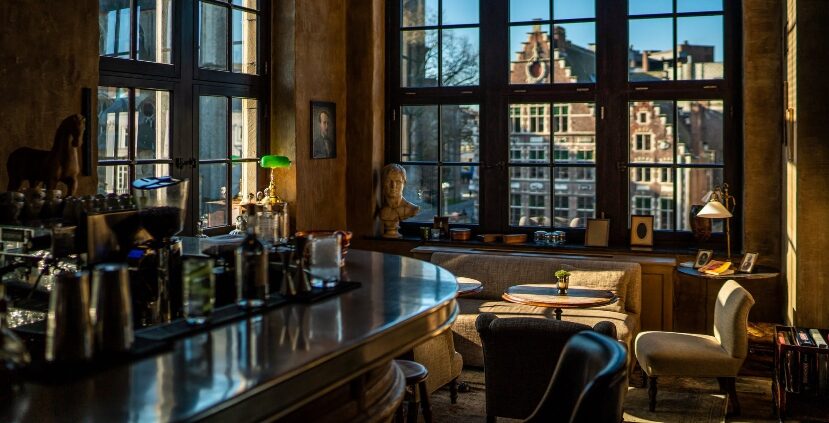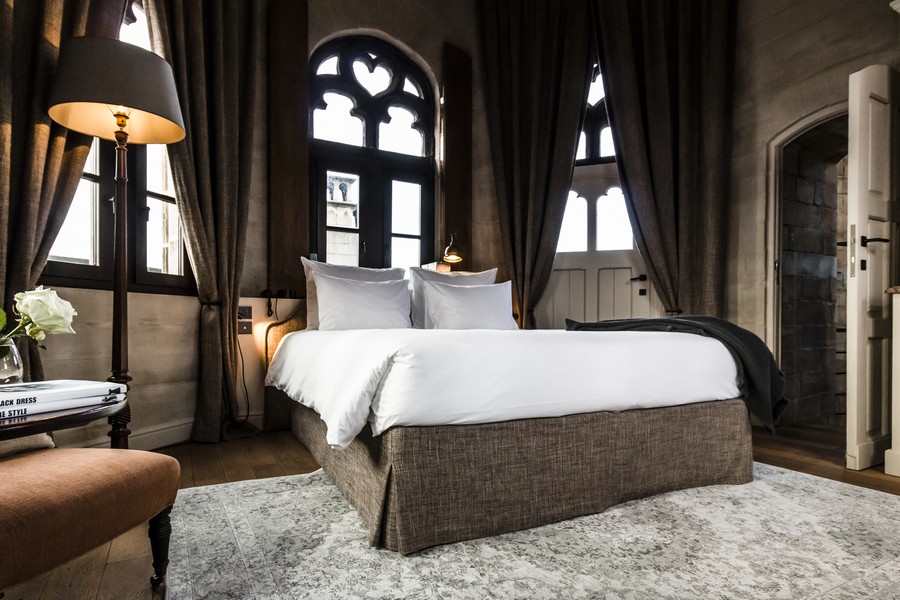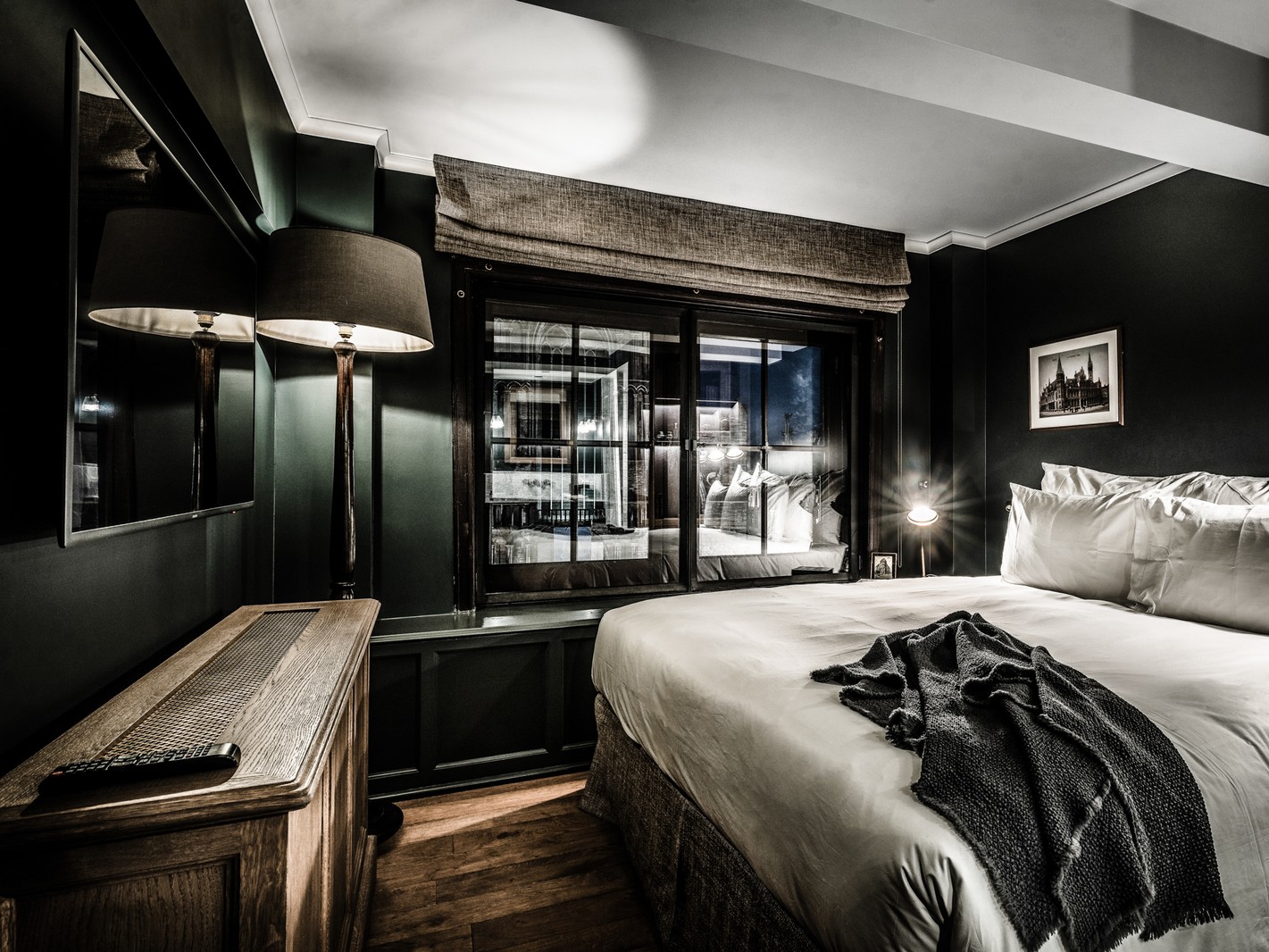
1898 The Post Ghent is a case study in how a city’s heritage can be preserved and simultaneously reimagined. This luxury hotel in Belgium weaves a spell-binding fantasy that mixes the medieval with the industrial. Looking out at the city from this building’s storied walls, you won’t just be seeing the historical landmarks of Ghent, but actually living in one.
Traveling in Ghent, you can see years of history folding and criss-crossing in remarkable ways. And it’s not just the impressive medieval Gravensteen castle that has a tale to tell. Countless buildings have past lives ready to enrapture you if you take a closer look. 1898 The Post Ghent is one such structure, situated in the historic city centre of Graslei along the river Leie. Making the most of its enchanting towers and vantage point over the area, this hotel, with its signature restaurant The Kitchen and its bar The Cobbler hosts guests in aura of splendour from years past.
The heritage of 1898 The Post Ghent dates back to its eponymous year, when architect Louis Cloquet – the man responsible for the city’s Saint Michael’s Bridge – finished his plans to build what would be the Hotel des Postes et des Télégraphes, the post office. Since its erection, the building has been witness to the history of Ghent, from the time of its first horse-drawn trams to its modern-day status as a city of vibrant street art, avid cyclists, and storybook cafes dotted alongside the iconic canal. In 2017, this building took on a new life when Zannier Hotels created 1898 The Post Ghent, opening up the top two floors for public use with a refined selection of 38 guest rooms.
Hallmarks of 1898 The Post Ghent’s architecture include looming octagonal towers that draw on neo-gothic and neo-renaissance aesthetics. An appreciation for the past is furthermore apparent in the approximately one hundred coats of arms and statues that adorn the exterior, representing Belgium’s provinces and political legacy. The main event, however, is the tower house with its clock that overlooks the city from 54 metres high. Once inside, the attention to detail continues. Channelling a 1900’s style interior design, antique pieces and sophisticated wood furnishings merge sleek, industrial qualities with a comfortable, old-fashioned atmosphere. Sloped ceilings held loftily high and skylights that infuse the space with a slow-blooming sunshine add to the feeling of grandeur.
"Looking out at the city from this building’s storied walls, you won’t just be seeing the historical landmarks of Ghent, but actually living in one."

If it weren’t for the contemporary amenities at the Tower Suite, you’d be forgiven for thinking you’d stepped into a mythical, fairy-tale bedchamber. This suite sits at the highest part of a medieval tower whose octagonal structure means that guests wake up to a panoramic, 360º view of Ghent. The two floors of this suite are connected by a staircase that snakes up the tower, adding further historical flair. The well-preserved authentic window frames are one of the many dark wooden elements in the suite, which, along with the marbled bathroom fittings, and brass accents all give the suite a regal air.

Another worthwhile offering at 1898 The Post Ghent is the duplex Carriage suite with its own private terrace. Soft white crystalline light bounces off the black-painted walls. This, combined with the dark hues of the antique furniture, envelops guests in an opulent atmosphere. The alcove that doubles as a bookshelf and the embrace of the armchair evoke the feeling of being a scholar in the olden days. To complete the experience, there is a terrace where you can sit with a beverage of your choice and admire two iconic sights that are worth being on your itinerary when traveling in Ghent. These are the Korenmarkt, the city square and marketplace that have existed since around the 11th century, and the 13th century St. Nicholas’ Church whose majestic grey-blue turrets watch over the city. Both are historical landmarks of Ghent that are a delight to behold.
"Sloped ceilings held loftily high and skylights that infuse the space with a slow-blooming sunshine add to the feeling of grandeur. "

The Kitchen is as cozy as the name suggests. This restaurant can be found at the hotel’s first floor and its focal point, an open fireplace, instantly sets the tone for the cheerful and relaxed experience ahead. It is open for an American-style breakfast buffet that includes freshly made croissants and other baked goods along with classics like decadent waffles and eggs cooked to your liking. The Kitchen also serves afternoon tea, where your tea of choice can be enjoyed with a seemingly endless array of pastries featuring delicate meringue and chocolate-filled bites.

As for drinks, 18989 The Post boldly announces itself as a Hotel and Cocktail Journey. The Cobbler is vital to that mission. This chic bar is one you’ll want to sink into and experience at your leisure. Paintings line the walls telling the history of Ghent through the lens of this building. Behind the bar awaits an expert team whose staff have been awarded in Belgium and beyond for their knowledgeable and creative ways with the art of the cocktail. The bar menu has a robust range of house cocktails, aperitifs, desert cocktails, and hot cocktails, which are prepared at a moment’s notice and refined to guests’ tastes. A range of tapas and curated cheese plates are available to accompany your drinks and, in the summertime, you can enjoy yourself at the terrace.
As a luxury hotel in Belgium, 1898 The Post Ghent is leaving its mark on the city’s architectural tapestry. The hotel boasts carefully designed interiors filled with antiques, a sleek bar with award-winning staff at the Cobbler, and delectable dining options at The Kitchen. With a stay in one of the many illustrious suites here, you can enjoy the comforts of modern-day hospitality while immersing yourself in the spirit of the historic.
















